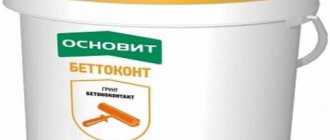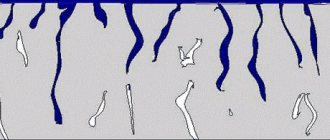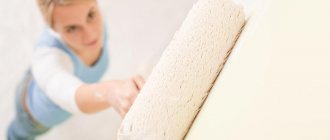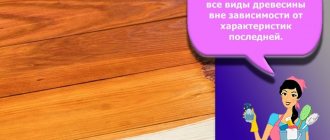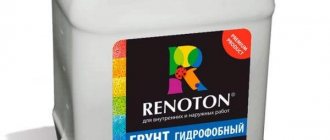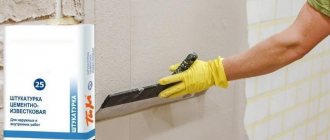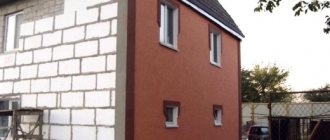Why do you need a primer?
Priming surfaces before finishing is an indispensable condition for proper and high-quality repairs.
Without pre-applied primer, the plaster will not adhere well to the wall or ceiling, followed by the putty, and the wallpaper will peel off. The paint will have to be applied in several layers. Those who do home renovations themselves know how important it is to prime the base before further processing. But not everyone pays attention to the characteristics and purpose of the compositions for its primary processing. There are a lot of primers, and each of them is designed to perform specific tasks. The correct choice of primer guarantees success in the repair. Primers are intended for:
- penetration deep into the substrate material, fastening its loose structure with the help of polymer fillers before finishing;
- reducing moisture absorption by porous surfaces;
- increasing the adhesion of the solution, glue to the wall or ceiling;
- protection against the development of fungi and mold in materials.
The retail chain sells universal primer compounds that are recommended for use on all types of surfaces and finishes. At the same time, there are products that have a very specific purpose. By purchasing a primer for a specific material, you can always count on excellent results in repair operations.
How long does it take for putty to dry on walls?
The use of modern building materials often raises some questions that even an experienced builder cannot always answer. When performing finishing work indoors, putty has become very popular - a special mixture that provides surface leveling and additional strength to the applied layer.
The quality of the finished coating is influenced by many factors; one of the most important will be the final drying of the applied material. How long it is necessary to wait between applying different types of putty mixture and some other “construction” issues will be covered in our article.
You can find out what Tex latex putty looks like by looking at this article.
Depending on the purpose, various mixtures are used. It is the qualitative composition of the dry matter that determines the characteristics of the finished layer and the feasibility of its implementation.
Typically, the following classification is used:
- Starting (rough) putty.
- Finishing or finishing putty.
- Universal mixture.
To correct severe surface defects, starting putty is used. Its characteristic feature will be the ability to apply a fairly thick layer of up to 15 mm. In this case, sometimes there is a need for a second layer, but enough time must pass between them. The use of putty on a wet surface is strictly prohibited! This will negate all efforts to level the surface, and also contribute to the appearance of fungus and mold.
A finishing layer of putty is applied at the final stage of repair; its purpose is to make the surface smooth and uniform. The layer of finishing putty should not exceed 5 mm, and for some mixtures this gap is only 2 - 3 mm. This layer is quite enough to hide minor defects and irregularities, since the most significant ones have already been removed by the starting putty.
The video tells how long it takes for the putty to dry on the walls:
Universal mixtures are usually more expensive than the first two types. This can be explained very simply, because when using such putty there is no need to buy and use two types of materials. This is why the universal mixture got its name, as it well levels out defects and differences in surface level, while forming an even and smooth top layer.
How to properly use putty for exterior work. you can find out by reading the article.
What type of materials is best to use depends more on individual preferences, as well as the reputation of the manufacturer. Typically, standard recommendations advise using mixtures from the same manufacturer and even one production batch so that the materials come into normal contact with each other. The popularity of the first two options is due to the ease of application and relatively low cost, but the universal type of the mixture is very useful if we are talking about small areas and there is no point in buying two packs of putty at once.
The form of release of putty mixtures may also differ. Basically, dry powder (cement or gypsum putty) is more popular in mass construction. It must be diluted in the required proportions with water. The dosage and method of application are usually indicated on the packaging.
The disadvantages of such a product will be the need to make a solution, as well as the purchase of a special attachment for a “mixer” drill and the purchase of the drill itself, if one is not found in the arsenal.
Unlike dry mixtures, ready-made putty (acrylic based) does not require preparation and is sold already diluted, and in various dosages, which is very convenient for purely cosmetic repairs. The disadvantages will be the impossibility of storing open packaging for a long time. That is why you should carefully compare the application area and the solution consumption rate, and only then buy a suitable product.
The video shows more information about how long it takes for finishing putty to dry on walls:
Types of primers
During repairs, you have to deal with surfaces made of different materials that require the use of one or another type of primer. When buying soil, you must clearly understand what it is intended for and what final result you can expect. Surface pre-treatment agents are divided according to the following qualities:
- composition (determines the basis of the products) - alkyd, acrylic, glyphthalic, mineral, quartz, epoxy, phenolic, etc.;
- degree of penetration (deep and normal);
- intended purpose - in the processing of plaster, concrete, metal, wood, plastic, universal compounds;
- place of use - for work outdoors or indoors;
- properties - anti-corrosion, anti-fungal, fire-resistant, moisture-resistant, etc.
The importance of soil in the primary processing of materials cannot be underestimated. Repairs are not cheap, and the cost of soil in the total costs will not amount to large sums, but the end result will please you.
Landscape soils
In this article, by landscape design we will mean the creation of flower beds and flower beds, small decorative forms (for example, alpine slides) in the garden plot, as well as their filling and decoration. Not all materials are suitable for this.
So, in landscape design they use:
- Vegetable soil - to create a lower layer for fertile soil
- Fertile soil, peat soil and black soil - for backfilling flower beds and lawns
- Grass - for decorative backfill
- Individual stones and boulders of rocky soil - as decorative elements for an alpine hill, rock garden, dry stream, gabion, garden path, artificial reservoir or pond
In this regard, we also recommend that you read our following articles:
- How to make an alpine slide
- How to make a pond at your dacha with your own hands
- How to make paths in the garden with your own hands
Types of primers by composition
The special qualities of primers are given by the materials from which they are made. For user convenience, manufacturers indicate on the packaging the type of primer, its scope of application, and the type of material to be processed.
Acrylic
Water-dispersed acrylic primers are the most common primers for construction applications. They do not have a strong odor, dry quickly, penetrate deeply into materials, have excellent adhesion, and are suitable for processing plaster, brick, wood, concrete, etc. In addition, the impregnation is environmentally friendly, it contains antifungal and antiseptic elements. It is waterproof and vapor permeable.
This type of material is created on the basis of acrylic polymers (dispersions) and additional components: drying oils, resins (which provide viscosity), fillers, additives, drying catalyst. The strength characteristics of the soil are given by the latex emulsion in the composition. By adding silicone components, acrylic primer significantly improves the condition of the surface before finishing.
When buying acrylic primer, pay attention to its functional properties. The solution may be intended for:
- impregnation of the base with a liquid composition with a low solids content (up to 10%) to a depth of 10-11 cm;
- strengthening a loose surface - during processing, a thick latex mixture fills the pores and smoothes out uneven areas;
- improving the adhesion of the base and finishing by using quartz components or marble chips in the solution;
- universal purpose.
Acrylic primers have a limited shelf life (up to 12 months), so during work they monitor their condition, check for smell, color, and clumping.
On sale you can find acrylic primers based on organic solvents. They are suitable for paints that are also organically soluble. The products have a pungent odor and are not harmless to human health, therefore they are suitable only for facade work.
Alkyd
This type of primer is created on the basis of alkyd polymers with the addition of zinc chromate or phosphate and a solvent. The composition includes antibacterial and antifungal components. All this makes the primer a universal means for preparing surfaces made of different materials for finishing. The only place where treatment with alkyd compounds is not allowed is a surface with a loose base (gypsum boards, plaster).
Alkyd primer takes a long time to dry (almost a day), but the resulting surface is reliably protected from moisture, fungi, mold, and rust. The composition levels the treated base, and after drying, putty and paint are firmly placed on the created film. Ideal for processing wood, metal, glass, concrete, plastic.
Alkyd primer is resistant to temperature changes, significantly reduces the consumption of the finishing coat, makes the base resistant to wear, prevents resin stains from protruding on wood, and prevents corrosion from developing on metal.
On sale you can find several types of alkyd primers with distinctive properties, including:
- glyphthalic – in addition to the already known characteristics, the primer has the property of enhancing the color of the finish coat, so you need to select a primer based on a tone close to the color of the paint;
- perchlorovinyl - due to its high toxicity, suitable only for external use, dries quickly, and plastered surfaces can also be treated;
- alkyd-urethane – characterized by high durability and quick drying;
- alkyd-acrylic - dries quickly, is water-based, has no strong odor, suitable for processing metal and wood.
There are many types of alkyd primer - you can always choose the right one for processing the necessary materials.
How to prime the walls before painting?
Painting walls instead of using wallpaper is becoming increasingly popular, since the color range of modern paints makes it possible to obtain any shades by tinting, and of course it is more practical.
A painted wall is much easier to update, either due to damage to the coating, or simply to change the interior, and for local work, global furniture moves or something similar will not be necessary, and the paints used will not irritate with a sharp, unpleasant odor.
The only negative side of painting is the visibility of any unevenness, and this is especially clearly visible in the immediate vicinity of lighting fixtures, so it is very important to carefully prepare the surface of the wall, making it perfectly smooth by first plastering it and then covering it with a layer of putty. When the finishing layer has dried, it is coated with an acrylic primer in two or three layers, which will ensure good adhesion of the paint to the base.
When the finishing layer has dried, it is coated with an acrylic primer in two or three layers, which will ensure good adhesion of the paint to the base.
For application, use a fur roller and a plastic tray; to process the corners, use a square brush; it is enough to generously moisten the corner with it once and not do this again in subsequent passes.
After the last layer has dried, run your hand over the surface of the wall, and if no fractions remain, then you can start applying paint.
Also watch a useful video on how to properly prime walls
Types of primers by purpose
When purchasing soil, you should carefully read the information on the packaging and make a choice in favor of a product that is suitable in composition and purpose.
Universal
The most common option used during repairs is the use of a universal primer. This product has good penetrating properties and good adhesion for a large number of materials: concrete, foam concrete, various types of plasters, putties, cement-sand, gypsum base, wood. The primer is applied to a dry surface free of dirt, dust and oil stains.
At the same time, the universal properties of penetrating and adhesive compositions are inferior in quality to special primers for wood, metal, and concrete.
Deep penetration
When purchasing primer for treating substrates before plastering, filling or painting, you should always pay attention to the condition of the surface. If it is porous or crumbling, then in order to improve its quality, it is necessary to treat it with a deep penetration primer. This product contains polymers and special additives, which, when penetrating into the pores of the material, harden and thereby strengthen it. The surface becomes monolithic and stops crumbling and crumbling. Plaster, putty, and paint applied to it firmly adhere to the base, do not crack, and do not change color or shade.
The membrane created by the deep penetration primer is waterproof - it allows air to pass through and repels water. This helps to carry out high-quality finishing, since glue, putty, and mortar do not lose moisture and can gain strength under natural conditions. The ability to penetrate deep into the pores of various materials makes the product a good tool for repairing concrete foundations that become covered with microcracks over time. Thus, a base made of concrete grade 300, after treatment with soil, restores its design characteristics (impregnation penetrates to a depth of 10 mm). Antiseptic additives added to deep soils help protect premises from the development of bacteria and fungus.
Concrete contact
Modern concrete contact material significantly speeds up the construction and repair process. It is used to apply finishing to smooth surfaces such as concrete, glass, metal. In essence, concrete contact is an adhesive primer that makes the surface rough, and finishing materials are applied to it using traditional glue.
The primer contains polymer binders and fillers (sand, talc). It is painted pink - this helps to notice the treated areas on the surface.
The adhesive primer is applied to the surface (with a brush, roller) in an even layer; on uneven surfaces, a two-layer application is made. Before finishing treatment, wait for the concrete contact to dry completely (4–6 hours). It is necessary to begin further finishing immediately after the soil has dried, otherwise it may become covered with dust and adhesion will become worse.
Concrete contact can be used on any previously cleaned surface. On loose foundations, it is recommended to first apply deep penetration soil, and only then apply concrete contact. Adhesive primer can be universal or special; it is used indoors and outdoors. It is environmentally friendly for humans. We wrote more about this material in the article “Why do you need a concrete contact primer?”
Primers for metal
The metal is treated with primer to prevent the surface from coming into contact with moisture and possible corrosion. After treatment, the base is covered with a protective film, onto which the finishing paint adheres well.
Primers for coating metal surfaces are divided into:
- phosphating – created on the basis of orthophosphoric acid, characterized by versatility of use and high adhesion;
- insulating – based on epoxy and alkyd resins;
- passivating – reducing the electrochemical properties of the metal, which prevents corrosion from developing;
- inhibitory – creating a protective layer of varnish on the surface;
- protective – containing zinc particles;
- transformative - decomposing rust already present on the metal surface.
There are alkyd primers on sale that can be used on metal as a primer and topcoat.
Primers with antiseptic
Manufacturers add additives to primer compositions that act as an antiseptic. This product is used to treat all types of surfaces that may harbor fungus, mold, as well as already affected areas. Antiseptic additives in deep penetration primers are especially effective. Such materials protect wood from the influence of moisture, fungus, and mold. The compositions make the surface smooth, reduce the ability of wood to absorb moisture, which subsequently saves paint when finishing.
Dilution of the primer mixture
Despite the fact that primer is not the most expensive construction component of a renovation, a considerable amount of it will be needed to finish one room. That is why it is necessary to dilute the soil with water, but this should be done carefully and carefully.
The amount of water used for this depends on the manufacturer and is usually indicated on the packaging. The generally accepted ratio is one part water to two parts primer. The resulting solution should be used on the same day. After some time it will deteriorate and lose its properties. It is better not to dilute the mixture applied to the plaster too much, since cement-sand mortars absorb moisture well.
How to choose a primer
Repairs to a house or apartment will not be complete without the use of primers, which will be needed for plastering, puttying, wallpapering, painting walls, ceilings and other work. When planning repairs, they determine in advance which surfaces need to be primed and with what compounds. You can purchase a universal emulsion and treat everything with it, but practice shows that high-quality results are obtained when using special compounds. Let us remind you that when choosing a primer product, take into account:
- the material of which the surface is made, its condition;
- conditions for using the primer: external/internal work, humidity, temperature;
- which will be applied as a finishing touch.
A high-quality primer substrate will give impeccable results in interior and exterior renovations.
Preparation and necessary tools
The method of applying the mixture is universal and is no different from applying other finishing materials. Immediately before applying the primer, any surface is cleared of the old coating, cleaned, sanded, and also degreased. It is worth noting that the number of approaches to priming walls is always strictly individual, but this must be done at least twice.
To apply the primer you will need:
- roller;
- brush;
- spray;
- capacity.
In each individual case and for each specific task, different tools can be used. For example, you can apply the mixture to a brick surface using a brush, but to smooth walls or plasterboard walls using a roller.
Briefly about the main thing
The primer is necessary so that after applying it, glue, paint or other wet compounds can be used without effort on the base.
Primer consumption depends on the condition of the base. You can also calculate it if you apply the composition to a piece of wall approximately 1 by 1 m, and then calculate how much mixture was used.
Concrete contact mixture is considered the most durable among the others. Of these, Knauf is considered the highest quality, which lasts up to 80 years and holds the base well with other materials.
